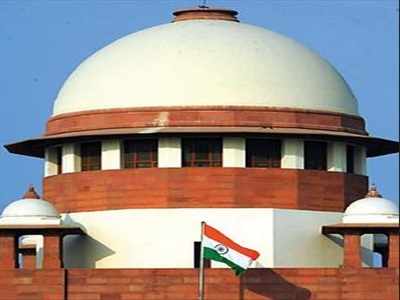NEW DELHI: The Supreme Court has asked the Union government to explain why it forced five lakh employees of Union Territory of Jammu and Kashmir to travel hundreds of kilometres to go before an ill-equipped pendency plagued Central Administrative Tribunal (CAT) for adjudication of their service disputes and not set up a tribunal in J&K itself.
A bench of Chief Justice S A Bobde and Justices A S Bopanna and Hrishikesh Roy on Friday asked the Centre to respond within four weeks to a PIL filed by Asheesh Singh Kotwal, whose counsel Arjun Garg claimed that pursuant to the Centre's April 29 notification conferring jurisdiction on CAT, Chandigarh, J&K High Court is in the process of transferring around 35-40,000 service related cases to Chandigarh.
Appearing for the petitioner in a video-conference hearing, senior advocate Ravindra Srivastava said with the abrogation of Article 370 and rendering of the state into two UTs, the employees of erstwhile state have been converted into central government employees. Earlier, the HC was adjudicating the service matters relating to state government employees.
Before August 9 last year, when the UTs came into existence, the service disputes of central government employees posted in the state were adjudicated by Chandigarh CAT. Srivastava said the CAT at Chandigarh, with a sanctioned strength of four members, is operating with one member at present and has nearly 50,000 cases pending and is wholly incapable of timely adjudicating thousands of additional cases.
"Transfer of 35-40,000 more cases from J&K to Chandigarh CAT would render the tribunal, operating with just one member, non-functional and seriously impede access to justice of employees of the UT of J&K, Srivastava said. The petitioner has sought quashing of the April 29 notification of the ministry of personnel conferring jurisdiction to CAT, Chandigarh, over all service matters relating to employees of the UT of J&K.
Kotwal said not only employees of J&K administration but those in Ladakh UT would also suffer because of Read More – Source
NEW DELHI: The Supreme Court has asked the Union government to explain why it forced five lakh employees of Union Territory of Jammu and Kashmir to travel hundreds of kilometres to go before an ill-equipped pendency plagued Central Administrative Tribunal (CAT) for adjudication of their service disputes and not set up a tribunal in J&K itself.
A bench of Chief Justice S A Bobde and Justices A S Bopanna and Hrishikesh Roy on Friday asked the Centre to respond within four weeks to a PIL filed by Asheesh Singh Kotwal, whose counsel Arjun Garg claimed that pursuant to the Centre's April 29 notification conferring jurisdiction on CAT, Chandigarh, J&K High Court is in the process of transferring around 35-40,000 service related cases to Chandigarh.
Appearing for the petitioner in a video-conference hearing, senior advocate Ravindra Srivastava said with the abrogation of Article 370 and rendering of the state into two UTs, the employees of erstwhile state have been converted into central government employees. Earlier, the HC was adjudicating the service matters relating to state government employees.
Before August 9 last year, when the UTs came into existence, the service disputes of central government employees posted in the state were adjudicated by Chandigarh CAT. Srivastava said the CAT at Chandigarh, with a sanctioned strength of four members, is operating with one member at present and has nearly 50,000 cases pending and is wholly incapable of timely adjudicating thousands of additional cases.
"Transfer of 35-40,000 more cases from J&K to Chandigarh CAT would render the tribunal, operating with just one member, non-functional and seriously impede access to justice of employees of the UT of J&K, Srivastava said. The petitioner has sought quashing of the April 29 notification of the ministry of personnel conferring jurisdiction to CAT, Chandigarh, over all service matters relating to employees of the UT of J&K.
Kotwal said not only employees of J&K administration but those in Ladakh UT would also suffer because of Read More – Source









